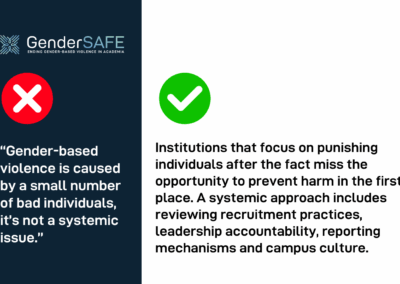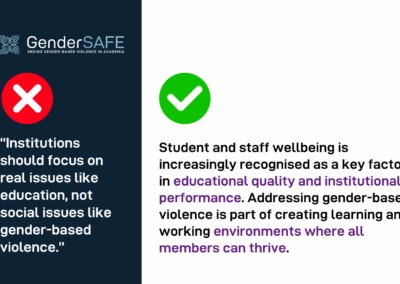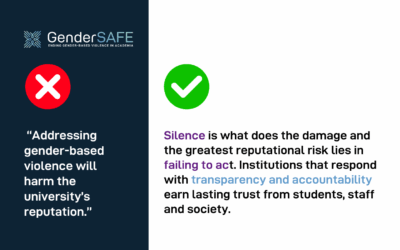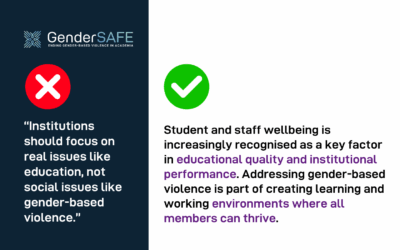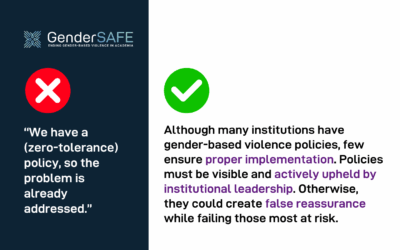When working to promote and implement effective responses to gender-based violence, change agents come across all sorts of resistances… This blog series aims to provide support by reframing arguments commonly encountered and help navigate challenging conversations with clarity, confidence and purpose. Drawing on the principles of strategic framing, this resource provides a better understanding and anticipation of common forms of resistance, as well as evidence-based, values-aligned messaging.
Minimising gender-based violence as the fault of a few individuals can be a defence mechanism for institutions attempting to protect its reputation.
The UniSAFE project underscores that gender-based violence in higher education is often embedded in academic hierarchies, informal networks and institutional silence. Power imbalances between students and staff, early-career and senior researchers or precarious and tenured staff can create environments where abuse goes unchallenged. Structural inequalities (e.g. gender, race, class, disability, etc.) further compound the risk.
The prevalence of gender-based violence across different settings, actors and types of violence in higher education institutions points to patterns that cannot be explained by a few ‘bad apples.’ Instead, these patterns reveal institutional blind spots, tolerance of the behaviour and a lack of robust safeguards.
“Addressing gender-based violence means more than reacting to incidents;
it means transforming institutional cultures where people look the other way,
where victims/survivors are unsupported and where those in power are shielded.”
Institutions that focus only on punishing individuals after the fact miss the opportunity to prevent harm in the first place. A systemic approach includes reviewing recruitment and promotion practices, leadership accountability, reporting mechanisms and campus culture.
Systemic problems require systemic solutions. Recognising gender-based violence as an institutional issue enables collective responsibility and targeted, sustainable responses. It also supports a shift from blame to accountability ensuring the focus is not just on individuals, but on the environment that allowed the harm to occur.
- “When harm keeps happening, we must ask: what in our system allows it?”
- “If we treat gender-based violence as an anomaly, we miss the opportunity to prevent it.”
- “Safety doesn’t come from punishment alone; it comes from prevention
Change agents can guide institutions toward recognising patterns rather than dismissing them as isolated incidents. By connecting the dots between individual cases and broader structural dynamics, they help shift the conversation from blame to accountability. They can advocate for institutional audits, crosslevel engagement and culture change strategies that ensure long-term prevention, not just reactive crisis management.
Understanding the Resistance
Framing gender-based violence as the result of a few isolated individuals overlooks the structural, cultural and institutional conditions that enable it. While individual accountability is essential, systemic change is what prevents recurrence. Genderbased violence is sustained by unequal power relations, tolerance for misconduct and organisational cultures that minimise or excuse harm, including by protecting perpetrators.
Too often, institutions respond by shielding those in power, managing disclosures internally, or denying that abuse occurred at all. These cover-ups can result in a culture of silence in which “everyone knew” but no one acted. Such dynamics not only retraumatise victims/survivors but also erode institutional trust and integrity. Focusing solely on individual behaviour obscures the broader responsibility to reform systems, challenge cultures of impunity, and build accountability structures that prevent future harm.
Minimising gender-based violence as the fault of a few individuals can be a defence mechanism protecting the institution’s self-image or avoiding complex conversations about power, culture and responsibility. It also allows stakeholders to distance themselves from the problem, rather than confront the full scope of institutional reform that is needed.
Communicating with different stakeholders
- To leadership: Emphasise that addressing systemic issues protects the institution from reputational, legal, and ethical risks and demonstrates strategic foresight.
- To students and staff: Stress the role of culture and collective responsibility in fostering safe environments.
- To the public: Show that the institution takes their safety seriously not only through individual sanctions, but by transforming harmful structures and cultures.

